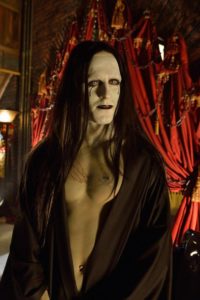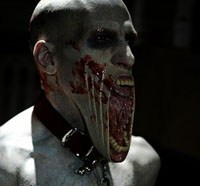We live very close to horror in the early 21st century. But then I wonder how much has really changed since, say, the 1940s (although the northern 75 percent or so of the North American continent was relatively at peace during the 20th century up to that time). The 19th century was actually quite violent (especially in Los Angeles); and the exterminations with which European North American descendants ‘won’ the West must have been pretty terrifying. Simple (or not so simple) violence (or fear of it) is not quite the same thing as horror, I realize; but it’s not entirely unrelated. More specifically, as a genre of art and entertainment, horror evolved more dramatically during the 19th century than any other period since the Middle Ages. Its evolution paralleled and is directly related to the evolution of attitudes towards childhood.
Changing attitudes towards childhood were probably first observed in 19th century England; and I sometimes think the English invented childhood right alongside Christmas (though the Brits continued sending their male children to boarding schools for initiation into both loves and terrors that dared not speak their names; and I’m also sure I could find a few Germans who might disagree with that). Some of this is a reaction to industrialism that physically transformed vast swaths of formerly bucolic landscape into nightmarishly scarrified pits and dark, terrifying workplaces; also (more positively) corresponding improvements and efficiencies in mass transportation and communications that connected one place (and culture) with another. (E.g., Charles Dickens and Hans Christian Andersen could both be fans of each other.) Our relations with both Nature and Culture had been transformed. Evil and excess had always lived among us; and after four centuries or so of progress and enlightenment, we were finally throwing some light onto the ‘dark’ side of human consciousness.
Americans had their own take on horror and probably invented their own brand of it, having already successfully transferred slavery and genocide to this side of the Atlantic; but even Edgar Allan Poe was strikingly influenced by French and English gothic horror. Eventually we managed to move on (manifest destiny and all, you know) – from the mysteries of nature and human psychology to chemistry (including bio- and human chemistry), and the domain of atomic and subatomic physics. In the late 20th and 21st century, we seem to go alternately extraterrestrial and viral-bacterial-granular, fracking the cellular organelles right alongside the bloody shale. H. P. Lovecraft was probably a pioneer in the 20th and post-20th century evolution of the genre – turning to the underside or inversion of both traditional western and eastern Mythos, even reaching out to the cosmos, the extra-terrestrial and astral – for something truly other-worldly, something with no foundation or connection to human values. (Hey it’s not all about us.) Alas he couldn’t save us from ourselves. Even as we know it’s not all about ourselves, the human population continues to grow.
Guillermo del Toro was definitely on the right track (certainly with the title) when he came up with the concept for (and with Chuck Hogan, co-wrote) The Strain – always intended to be a television series, but which began, uh, life as a book (you can almost tell this from reading a few excerpts of the book). In all likelihood, as viruses mutate and multiply in ever more strains in ever more decreasingly temperate regions of the planet, catastrophic disease and infection is what may finally decimate us and (who knows?) maybe even salvage enough biodiversity to save the planet and the few and newly humbled amongst us who remain. The Strain is framed as a trans-Atlantic vampire story; but in all likelihood, you wouldn’t search for its origins back across the pond in Hungary or Romania or even Transylvania, but more likely sub-Saharan Africa or parts of South America. Having burned down most of the Amazon rainforest (where we probably could have found most of the cures), Brazil could probably yield a rich harvest of such strains; but I guess we’ll just have to wait until after all the post-Para/Olympics/impeachment fallout.
The Strain is both the eternal vampire story – that dream of agency in both former and projected future lives beyond death (albeit on a megalomanical scale) – and very much a horror story of the moment. The main protagonist is Dr. Ephraim Goodweather, an epidemiologist. The ‘wise old man/consigliere’ is a Romanian Jew named Abraham (seriously). Setting aside ‘The Master’ (that is the ancient master vampire himself), their chief nemesis is a multi-billionaire named Eldritch Palmer. (As opposed to ‘Palmer Eldritch’ – an iconic character in a 1965 science fantasy/fiction novel by Philip K. Dick set during a future time on earth when daylight temperatures are so high, people have to wear special air-conditioned suits just to move around. Sound familiar? Stick around ten years – it will.) Climate change, bureaucratic paralysis, economic inequality and oligarchy, viral (vampiral) pandemics – welcome to our world. The usual devices and motives are all here: flesh-eating symptoms, metastasizing viral/bacterial agents (or just plain worms), a constant flow of newfangled high-tech remedies, zombie-like hordes of adversary creatures. ‘The times – they are a changing!’
The series is essentially structured as a suspense procedural with both vulnerable characters and their implacable (if not entirely invulnerable) vampiric or criminal nemeses. ‘Eph’ (Corey Stoll – perfect in the role) is both a recovering alcoholic and in a custody battle over his son, Zach. Gabriel Bolivar is the Master Vampire, now embodied as a rock star (naturally!) – flamboyant, philandering, and with a raging appetite for drugs as well as blood, bodies and acolyte vampires. (Robin Atkin-Downes was the ur-Master before the major ‘shape-shift.’) Like any fan, I have my own fantasy re-casting in which Russell Brand plays the role as a slightly randy update on someone like Alice Cooper or such. As it stands now, he’s played by Jack Kesy.) Some of the supporting and recurring characters are very well done – both affecting and hilarious. I couldn’t possibly list them all; but some of the character ID’s alone are hilarious: consider, e.g., Samantha Mathis as ‘Justine Feraldo,’ a city councilwoman representing Staten Island. The forensic detail can be as meticulous as it is occasionally ridiculous, so we get that this is a heavy production to carry on every level; but the writers room must be a gas to be in sometimes.
Having seen only a handful of episodes between the first and second seasons, it’s hard to make a definitive recommendation; and it’s not as if the repetitive violence can’t get a bit heavy-handed at times – but then we could say that about the front page of the newspaper. (The lead always seems to bleed, lately.) This is a pretty entertaining series overall; and – who knows? – maybe you can pick up some ideas about surviving the next decade.
One thing I like about The Strain is that it brings it all back to the neighborhood – or at least a neighborhood that is more or less recognizable; i.e., Brooklyn. (Though maybe more ‘less’ – it’s shot in Toronto.) The rest of New York doesn’t look nearly so familiar (probably because it isn’t). I loved that one of the third season teasers featured a ‘strained’ (and clearly steroidal) Statue of Liberty, unleashing her viral tongue like a blowtorch. (Might have been a nice touch to make the Strained Madame Liberté look like W; but there’s always next season.) But we know the ‘Strain’ is global, so I’m wondering if the showrunners (including Carlton Cuse, of Lost, among many other credits) have any plans to open up the drama beyond the tri-state area. I have no doubt many interesting brother and sister ‘strains’ (and their nemeses) could be placed everywhere from Los Angeles to Istanbul to Ulan Bator. (Or why not take the post-viral vampire to Tokyo – full circle to the capital of the post-atomic monster?)
But as most horror writers from Shelley and Stoker to Stephen King know, the horror is much closer at hand. It’s – cue the horror movie trailer voice-over – right here: in our towns or villages, down the street, or right next door. Or, as I was reminded a couple of Sundays ago reading the Sunday Styles section of The New York Times, right across the breakfast table. The political world is full of odd couples like James Carville and Mary Matalin (or for that matter the Clintons themselves). But these were not quite the same – although the male partner in one couple had one cloven foot planted squarely in the political arena. It was this couple – Matt Latimer and Anna Sproul-Latimer that elicited the morning’s ‘scream-at-the-screen’ moment. Matt was an ex-speechwriter for George W. Bush. As if that didn’t scream Rosemary’s Baby enough for us, there was the appearance of Mephisto himself at their wedding in the person of former W Defense Secretary Donald Rumsfeld. What? Were you captivated by the thought of a walk on the beach with Death after the ceremony? Distracted by the three ‘6’s tattooed to your fiancé’s forehead? Weren’t any of your girlfriends there screaming, No!?
Guess not. But then it’s the sort of thing one actually does run directly into, however infrequently, and on rare occasion, as if steered there by fate. It’s something we carry forward from childhood, and sometimes we can make ourselves believe it was predicated by childhood events and experiences. But I’ll spare you those premonitions seen in retrospect for the moment and leave you to the neighborly terrors you may look forward to later this evening.


